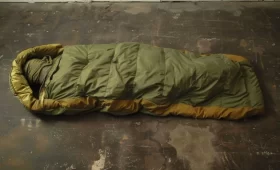
Are you tired of struggling to fit your sleeping bag back into its stuff sack? It’s time to master the art of efficient packing. Whether you’re preparing for a camping trip or looking to store your sleeping bag long-term, knowing how to pack it properly can make a world of difference. Say goodbye to bulky bags and hello to a neatly packed sleeping bag that takes up minimal space!
- Flatten your sleeping bag before stuffing it to remove excess air
- Stuff the bag instead of rolling it to achieve a smaller packed size
- Start packing from the bottom to ensure even distribution
- Stack the sleeping bag as you stuff it to avoid tearing or twisting
- Consider investing in a compression stuff sack for additional space savings
Flatten the Sleeping Bag Before Stuffing
Before attempting to stuff your sleeping bag, it’s important to flatten it. This step helps remove excess air trapped in the insulation, allowing for easier packing and a smaller packed size.
To flatten your sleeping bag, start by spreading it out on a flat surface. Then, firmly sweep your arms across the bag, applying gentle pressure to push out the air. This motion helps compress the insulation and removes any excess air pockets.
By flattening your sleeping bag before stuffing it, you create a more compact and efficient packing solution. Removing the excess air not only reduces the packed size but also ensures better insulation and warmth during your outdoor adventures.
Why Flatten Your Sleeping Bag?
Flattening your sleeping bag is an essential step in achieving efficient packing. By removing excess air, you create more space in your backpack for other essential gear while ensuring your sleeping bag maintains its insulation properties.
When you leave air trapped in the sleeping bag, it takes up unnecessary space and can cause your bag to bulge, making it difficult to fit into your pack. Flattening the sleeping bag allows you to maximize the available space and pack efficiently.
Additionally, a flat sleeping bag is less likely to shift or move around inside your backpack, ensuring a more stable and comfortable carrying experience. So, don’t overlook the importance of flattening your sleeping bag before stuffing it!
Stuff Instead of Roll
When it comes to packing your sleeping bag, the traditional method of rolling may not be the most efficient option. Instead, consider stuffing your sleeping bag into the stuff sack. This technique not only saves time but also helps remove more air from the bag, resulting in a smaller packed size.
Whether your sleeping bag is filled with down or synthetic insulation, stuffing it provides several benefits. Firstly, it allows you to remove more air from the bag, maximizing the available packing space. With less air trapped inside, your sleeping bag can be compressed further, resulting in a compact and efficient pack.
By opting to stuff your sleeping bag, you can achieve a small packed size, which is especially important for backpackers and outdoor enthusiasts looking to save space. Every inch counts when you’re on the move, and a smaller packed size allows you to fit more gear in your backpack or suitcase.
Moreover, the stuff method offers convenience and simplicity. Rolling a sleeping bag can be time-consuming and sometimes frustrating, as ensuring a tight and compact roll requires practice. On the other hand, stuffing a sleeping bag is a straightforward process that can be done quickly and easily.
To stuff your sleeping bag, unzip it fully and spread it out. Take one end of the bag and start loosely stuffing it into the stuff sack, pushing out as much air as possible. Continue to stuff the bag until it fits snugly into the sack. Ensure that the zipper of the stuff sack is properly closed to secure your sleeping bag in place.
Remember, when packing your sleeping bag, the goal is to remove air and achieve a small packed size. By choosing to stuff instead of roll, you can simplify the packing process, maximize space, and ensure an efficient pack for your next adventure.
Expert Tip:
The stuff method not only saves space but also helps preserve the insulation of your sleeping bag. By removing excess air, you protect the loftiness of the insulation, ensuring that your sleeping bag retains its optimum thermal performance.
Start at the Bottom
Efficient packing of a sleeping bag requires a strategic approach that maximizes space and minimizes the risk of damage. To achieve this, it is best to start at the bottom of the bag when packing it into the stuff sack.
The footbox section of many sleeping bags is designed with additional insulation, which can result in more air getting trapped in this area. By starting at the bottom and gradually stacking the sleeping bag, you ensure even distribution of the insulation throughout the bag.
This method not only helps maintain the integrity of the sleeping bag but also minimizes the risk of tearing or damage when pulling the bag out of the stuff sack. By starting at the bottom, you can efficiently pack your sleeping bag while taking care of its longevity.
Even Distribution for Optimal Performance
Proper distribution of insulation in the sleeping bag is crucial for optimal performance. By starting at the bottom, where there is often more insulation, you ensure that the warmth is evenly spread across the bag.
This even distribution helps maximize the bag’s ability to retain heat and keeps you comfortable throughout your outdoor adventures. So, whether you’re camping in chilly temperatures or venturing into colder climates, starting at the bottom sets the foundation for an efficiently packed and well-performing sleeping bag.
Stack as You Stuff
When it comes to efficiently packing your sleeping bag, it’s crucial to stack it carefully as you stuff it into the stuff sack. By following this method, you can prevent any twisting or tightly wrapping of the bag, which could potentially lead to tearing or other damage. In addition, stacking your sleeping bag helps maintain its integrity and ensures an efficient packing process.
Begin with the footbox at the bottom and gradually stuff the bag from bottom to top. This technique helps distribute the insulation evenly throughout the bag and avoids any concentration of air or insulation in one area.
As you stack the sleeping bag, envision each layer conforming to the previous layer, creating a neatly packed shape. This method not only prevents twisting but also makes it easier to pack other items on top of or around the sleeping bag in your backpack or suitcase.
Remember, the goal is to pack your sleeping bag tightly without compromising its structure. Practice this stacking technique to achieve efficient packing and ensure your sleeping bag is always ready for your next adventure.
Prevent Twisting and Avoid Tearing
“Stacking your sleeping bag as you stuff it not only prevents twisting but also avoids the risk of tearing. This packing method ensures that your sleeping bag remains intact and ready for your next outdoor excursion.” – Outdoor Gear Experts
By carefully following the stack-as-you-stuff technique, you can optimize the packing process and minimize the chances of any damage occurring. This method keeps your sleeping bag in pristine condition and ready to provide you with a comfortable night’s sleep on your outdoor adventures.
Invest in Helpful Compression Tools
When it comes to efficient packing, investing in a compression stuff sack can make all the difference. These ingenious tools utilize straps to compact your sleeping bag, making it easier to fit into your backpack or luggage. Not only does a compression stuff sack optimize space savings by reducing the volume of your sleeping bag, but it also allows for additional gear to be packed alongside it.
By using a compression stuff sack, you can compress your sleeping bag to a smaller size without exerting much physical effort. The straps on the sack enable you to tightly secure the bag, removing excess air and maximizing the available space in your pack. This means you’ll have more room for other essential camping or backpacking gear, ensuring you’re well-prepared for your adventure.
Moreover, compression stuff sacks offer the versatility to compress other soft gear items in addition to your sleeping bag. For example, you can use the compression sack to further reduce the size of your backpacking pillow or squeeze in those extra layers of clothing. This efficient space optimization allows you to make the most of your available storage capacity and ensures that you’re packing efficiently.
Long-Term Storage
Proper long-term storage is crucial for maintaining the quality of your sleeping bag. After a memorable outdoor adventure, it’s important to avoid compressing your sleeping bag for extended periods. Instead, opt for a large mesh or fabric storage sack that allows for breathability. This enables the insulation to remain uncompressed, especially for down-filled bags that are sensitive to compression. Synthetic insulation also benefits from being stored uncompressed, making it essential to use a dedicated storage sack or any large breathable fabric sack for your sleeping bag.
By choosing a breathable storage sack, you provide an environment that prevents the insulation from being compressed, ensuring the long-term durability and performance of your sleeping bag. Proper storage is particularly essential for down-filled bags, as compression can cause the feathers to lose their loft and insulation properties over time.
Conclusion
Efficient packing of a sleeping bag is essential for outdoor adventures. With these tips, you can easily pack your sleeping bag back into its stuff sack, ensuring a hassle-free packing experience. First, remember to flatten the bag before stuffing it to remove excess air and achieve a smaller packed size.
Starting at the bottom of the bag and stacking it as you stuff will ensure even distribution and prevent any potential tearing or damage. Consider investing in a compression stuff sack for additional space savings, allowing you to optimize the room in your pack.
When it comes to long-term storage, it’s important to choose breathable solutions that prevent compression. Whether it’s a large mesh or fabric storage sack, maintaining the integrity of your sleeping bag’s insulation is crucial for its longevity.
By following these efficient packing tips and storing your sleeping bag properly, you can ensure its excellent condition for future outdoor adventures. So, pack smart and rest easy knowing your sleeping bag is always ready for your next trip!


